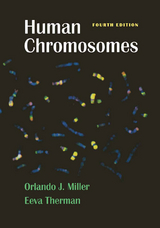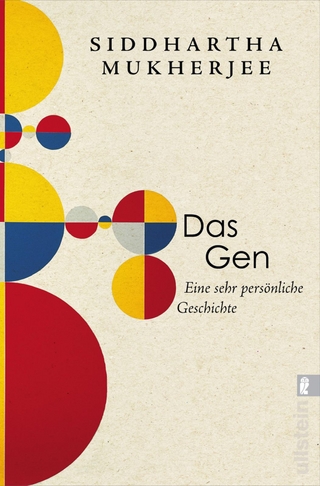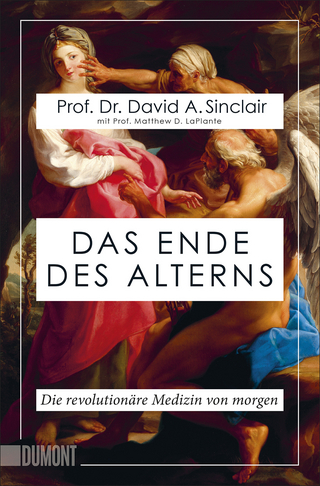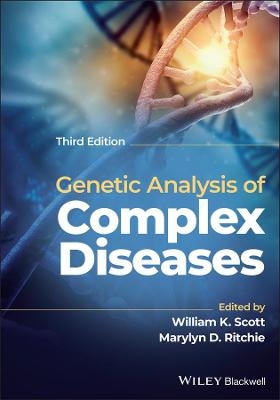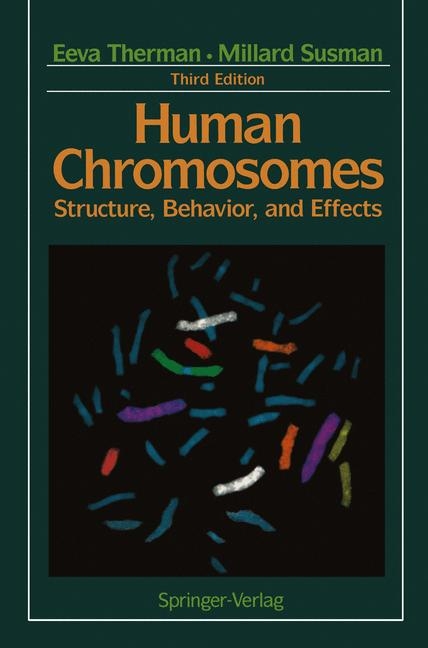
Human Chromosomes: Structure, Behavior, and Effects
Springer-Verlag New York Inc.
978-0-387-97871-0 (ISBN)
- Titel erscheint in neuer Auflage
- Artikel merken
1. Origins and Directions of Human Cytogenetics.- The Dark Ages.- The Hypotonic Era.- The Trisomy Period.- Chromosome Banding Era.- Human Sex Chromosomes.- Evolution of Human Chromosomes.- Nomenclature of Human Chromosomes.- The Molecular Era.- Ultrastructure of Eukaryotic Chromosomes.- Functional Structure of Human Chromosomes.- Structure of Interphase Nuclei.- Somatic Cell Cytogenetics.- Sex Chromosomes and Sex Determination.- Mutagenesis Studies.- Chromosome Instability Syndromes.- Mapping of Human Chromosomes.- Chromosomes and Cancer.- Clinical Cytogenetics.- The Future of Human Cytogenetics.- References.- 2. Structure of the Eukaryotic Chromosome and the Karyotype.- Metaphase Chromosome.- Primary Constriction.- Secondary Constrictions.- Characterization of Metaphase Chromosomes.- Chromosome Number.- Chromosome Size.- Shape of Chromosomes.- DNA Content of Nuclei.- Human Chromosome Complement.- Banded Human Karyotype.- Euploid Chromosome Changes.- Aneuploid Chromosome Changes.- Structural Changes in Chromosomes.- References.- 3. Mitotic Cycle and Chromosome Reproduction.- Significance of Mitosis.- Interphase.- Prophase.- Prometaphase.- Metaphase.- Anaphase.- Telophase.- Nondisjunction and Loss of Chromosomes.- Mitotic Cycle.- Chromosome Replication.- References.- 4. Methods in Human Cytogenetics.- Direct Methods.- Tissue Culture Techniques.- Prenatal Studies.- Meiotic Studies.- Sex Chromatin Techniques.- Banding Techniques.- Prophase Banding.- Replication Studies.- Nomenclature of Human Chromosomes.- Quantitative Methods.- References.- 5. Molecular Methods.- Fragmentation of DNA.- Cloning.- Flow Cytometry and Chromosome Sorting.- In Situ Hybridization.- Polymerase Chain Reaction (PCR).- Yeast Artificial Chromosomes (YACs).- References.- 6. Longitudinal Differentiation of Eukaryotic Chromosomes.- Longitudinal Differentiation of Chromosomes.- Molecular Differentiation of Chromosomes.- Prebanding Studies.- Banding Studies on Human Chromosomes.- Nucleoli and Chromocenters.- Constitutive Heterochromatin.- Facultative Heterochromatin.- Transcription of Chromosomes.- Role of Heterochromatin.- References.- 7. Significance of Chromosome Bands.- Chromosome Banding.- Role of the Bands.- Future Problems.- References.- 8. Architecture and Function of the Eukaryotic Chromosome.- Chromosome Architecture.- The Chromosome Scaffold.- Architecture as Related to Regulation of Gene Function.- Telomeres.- Centromeres and Kinetochores.- Relationship between Chromosome Architecture and Nuclear Architecture.- References.- 9. Chromosome Structural Aberrations.- Origin of Structurally Abnormal Chromosomes.- Chromosome Breaks and Rearrangements.- Chromatid Breaks and Rearrangements.- Telomeres.- Telomere Associations.- Origin of Dicentric Chromosomes, Including Isodicentrics and Isochromosomes.- Inactivation of the Centromere.- Misdivision.- Centric Fusion.- Triradial and Multiradial Chromosomes.- Fragile Sites.- References.- 10. Causes of Chromosome Breakage.- Mechanisms of Chromosome Breakage.- Spontaneous Chromosome Breaks.- Radiation-Induced Breaks.- Chemically Induced Breaks.- Virus-Induced Breaks.- Enzyme-Induced Breaks.- Genetic Causes of Chromosome Breaks.- Nonrandomness of Chromosome Breaks.- Methods in Chromosome-Breakage Studies.- Rules for Chromosome-Breakage Studies.- References.- 11. Chromosome Instability Syndromes.- Genotypic Chromosome Breakage.- Bloom Syndrome.- Fanconi Anemia.- Ataxia Telangiectasia.- Xeroderma Pigmentosum.- Other Conditions with Increased Chromosome Aberrations.- Chromosome Instability Syndromes and Cancer.- References.- 12. Sister Chromatid Exchanges and Mitotic Crossing-Over.- Detection of Sister Chromatid Exchanges.- Occurrence of SCE.- SCE in Mutagenesis Research.- Mitotic Crossing-Over.- BS as a Model for Chromosome Instability Syndrome.- Segregation after Mitotic Recombination.- Origin of Mitotic Chiasmata.- Gene Amplification.- References.- 13. Cell Fusion, Prematurely Condensed Chromosomes, and the Origin of Allocyclic Chromosomes.- Prematurely Condensed Chromosomes (PCC).- Uses of PCC Formation.- Origin of Allocyclic Chromosomes.- References.- 14. Chromosome Arrangement in Interphase and in Differentiated Nuclei.- Chromosome Arrangement.- Hypotheses Proposing a Nonrandom Chromosome Arrangement.- Chromosome Arrangement and Differentiation.- Conclusions.- References.- 15. Modifications of Mitosis.- Endoreduplication.- Polyteny.- Endomitosis.- C-Mitosis.- Restitution.- Processes Giving Rise to Multinucleate Cells.- Amitosis.- Multipolar Mitoses.- Other Mitotic Abnormalities.- References.- 16. Chromosomal Differentiation of Cells.- Methods.- Somatic Polyploidy.- Amplification and Underreplication.- Chromosomes and Cell Differentiation.- References.- 17. Main Features of Meiosis.- Significance of Meiosis.- Meiotic Stages.- Premeiotic Interphase.- Leptotene (or Leptonema).- Zygotene (or Zygonema).- Pachytene (or Pachynema).- Diplotene (or Diplonema).- Diakinesis.- Metaphase I.- Anaphase I.- Telophase I.- Interkinesis.- Meiotic Division II.- Some Meiotic Features.- References.- 18. Details of Meiosis.- Structure of Chiasmata.- Number of Chiasmata.- Synaptonemal Complex.- Meiotic Behavior of More Than Two Homologous Chromosomes.- Human Meiosis.- Premeiotic and Early Meiotic Stages in the Human.- Meiosis in Human Spermatocytes.- Behavior of X and Y Chromosomes.- References.- 19. Meiotic Abnormalities.- Nondisjunction of Autosomes.- Nondisjunction of Sex Chromosomes.- Misdivision of the Centromere.- Chromosomally Abnormal Human Sperm.- Male Infertility.- Environmental Causes of Meiotic Nondisjunction.- Parental Age.- Genetic Causes of Nondisjunction.- Origin of Diploid Gametes.- References.- 20. Human Sex Determination and the Y Chromosome.- Y Chromosome.- Sex Determination in Humans.- Fine Structure of the Y Chromosome.- Genes on the Y Chromosome.- Abnormal Y Chromosomes.- References.- 21. Human X Chromosome.- Structure of the X Chromosome.- X Chromatin or Barr Body Formation.- Inactivation of the X Chromosome.- Reactivation of the X Chromosome.- X;Y Translocations.- Sex Reversal.- References.- 22. Abnormal Human Sex Chromosome Constitutions.- Aneuploidy of X Chromosomes in Individuals with a Female Phenotype.- Sex Chromosome Aneuploidy with a Male Phenotype.- Various Abnormalities in X Chromosome Behavior.- References.- 23. Functional Structure of the Human X Chromosome.- Functional Map of the Human X Chromosome.- Inactivation Center.- Always-Active Regions.- Critical Region.- Summary of X Inactivation.- References.- 24. Numerically Abnormal Chromosome Constitutions in Humans.- Abnormalities of Human Chromosome Number.- Human Triploids.- Imprinting and Uniparental Disomy.- Human Tetraploids.- Hydatidiform Moles.- Anomalies Caused by Chromosomal Imbalance.- 13 Trisomy (Di Trisomy, Patau Syndrome).- 21 Trisomy Syndrome (Down Syndrome).- 18 Trisomy Syndrome (Edwards Syndrome).- Other Autosomal Aneuploidy Syndromes.- Spontaneous Abortions.- Nonrandom Participation of Chromosomes in Trisomy.- References.- 25. Structurally Abnormal Human Autosomes.- Structurally Abnormal Chromosomes.- Chromosomal Polymorphisms.- Quantitative Comparisons.- Pericentric Inversions.- Paracentric Inversions.- Deletions or Partial Monosomies.- Cri du Chat (Cat Cry) Syndrome.- Ring Chromosomes.- Insertions.- Duplication or Pure Partial Trisomy.- Mosaicism.- References.- 26. Reciprocal Translocations.- Occurrence.- Breakpoints in Reciprocal Translocations.- Multiple Rearrangements.- Phenotypes of Balanced Translocation Carriers.- Phenotypes of Unbalanced Translocation Carriers.- Fetal Death.- Examples of Translocation Families.- Meiosis in Translocation Carriers.- Genetic Risk for Translocation Carriers.- Sperm Chromosomes in Meiotic Segregation Analysis.- References.- 27. Robertsonian Translocations.- Occurrence.- Monocentric and Dicentric Chromosomes.- Nonrandom Participation of Acrocentric Chromosomes in RTs.- Causes of Nonrandom Participation of Chromosomes in RTs.- Segregation in Carriers of Robertsonian Translocations.- Segregation in Sperm Cells of RT Carriers.- Interchromosomal Effects.- Conclusions.- References.- 28. Double Minutes and Homogeneously Stained Regions.- What are DMs and HSRs?.- Structure of Double Minutes.- Homogeneously Stained Regions and C-Minus Chromosomes.- DMs and HSRs as Expressions of Gene Amplification.- DMs and HSRs are Interchangeable.- Origin of DMs and HSRs.- Significance of HSRs and DMs.- References.- 29. Chromosomes and Oncogenes.- What is Cancer?.- Cancer Induction.- Oncogenes.- Reciprocal Translocations and Oncogenes.- Cancer Suppressor Genes or Anti-Oncogenes.- Multistep Carcinogenesis.- References.- 30. Chromosomal Development of Cancer.- Chromosomes and Cancer.- Chromosome Studies in Ascites Tumors.- Chromosome Studies in Cancer.- Stemline and Tumor Development.- Mitotic Aberrations in Cancer.- Selection and Tumor Progression.- References.- 31. Mapping of Human Chromosomes.- Gene Mapping.- Identifying Map Sites.- Family Studies.- Somatic Cell Genetics.- Chromosome Rearrangements.- Other Uses of Deletions and Translocations in Mapping.- In Situ Hybridization.- Recombinant DNA Gene Mapping Methods.- Conclusions.- References.- Index of Names.
| Erscheint lt. Verlag | 13.1.1995 |
|---|---|
| Reihe/Serie | Springer Study Edition |
| Zusatzinfo | black & white illustrations |
| Verlagsort | New York, NY |
| Sprache | englisch |
| Maße | 156 x 234 mm |
| Gewicht | 554 g |
| Themenwelt | Studium ► 2. Studienabschnitt (Klinik) ► Humangenetik |
| Naturwissenschaften ► Biologie ► Humanbiologie | |
| Naturwissenschaften ► Biologie ► Zellbiologie | |
| ISBN-10 | 0-387-97871-2 / 0387978712 |
| ISBN-13 | 978-0-387-97871-0 / 9780387978710 |
| Zustand | Neuware |
| Informationen gemäß Produktsicherheitsverordnung (GPSR) | |
| Haben Sie eine Frage zum Produkt? |
aus dem Bereich
